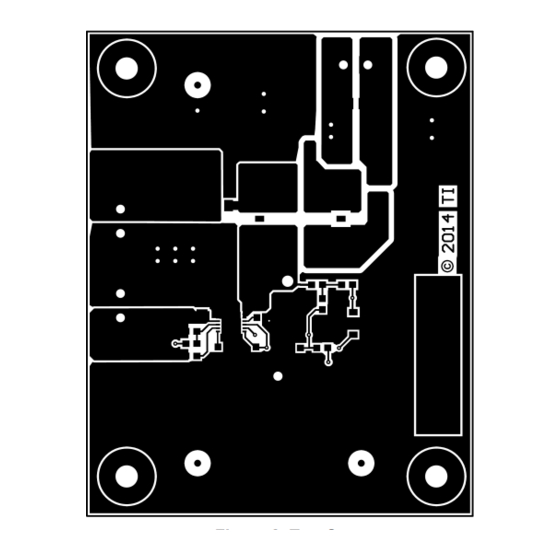Summary of Contents for Texas Instruments LM5160
- Page 1 LM5160 Fly-Buck (Isolated Buck) User’s Guide User's Guide Literature Number: SNVU408A October 2014 – Revised February 2015...
-
Page 2: Table Of Contents
Input/Output Connector Description ........................Operation ........................Board Layout ........................... Schematic ........................Bill of Materials ..................Performance Curves with LM5160 .......................... Revision History Table of Contents SNVU408A – October 2014 – Revised February 2015 Submit Documentation Feedback Copyright © 2014–2015, Texas Instruments Incorporated... - Page 3 = 600 mA and I = 200mA (Tx: Wurth Elektronik #: 744873220) OUT2 OUT1 List of Tables ................Default Board Specification with LM5160 ..................Alternate Configuration with LM5160 ............ LM5160DNTFBKEVM Bill of Materials for 300 kHz Configuration ................Bill of Materials for Alternate Configuration SNVU408A –...
-
Page 4: Setup
600 mA. The coupled inductor (transformer) T1 utilized in this board is optimized for small solution size and is not rated for the peak current limit of LM5160. If short circuit protection is required, T1 should be replaced with a coupled inductor (flyback transformer) with primary side saturation current rating greater than the peak current limit of LM5160. -
Page 5: Default Board Specification With Lm5160
The nominal switching frequency is 300 kHz. The high side and low side MOSFETs are integrated in the LM5160 and LM5160A. The EVM is designed to demonstrate a small solution size in the WSON-12 lead-less package for low power isolated bias applications. -
Page 6: Schematic
LM5160, the placeholder for diode D2, as given in Figure 1, must remain unpopulated under all cases. For more information about the difference between the LM5160A and the LM5160, please refer to the LM5160 Datasheet (SNVSA03). LM5160 User’s Guide SNVU408A –... -
Page 7: Bill Of Materials
750314597 10.16 mm Elektronik Test Point, Multipurpose, Yellow, TH Testpoint Keystone 5014 IC, PWM, COT Regulator DNT0012B Texas LM5160DNT Instruments SNVU408A – October 2014 – Revised February 2015 LM5160 User’s Guide Submit Documentation Feedback Copyright © 2014–2015, Texas Instruments Incorporated... - Page 8 750314597 10.16 mm Elektronik Test Point, Multipurpose, Yellow, TH Testpoint Keystone 5014 IC, PWM, COT Regulator DNT0012B Texas LM5160DNT Instruments LM5160 User’s Guide SNVU408A – October 2014 – Revised February 2015 Submit Documentation Feedback Copyright © 2014–2015, Texas Instruments Incorporated...
-
Page 9: Performance Curves With Lm5160
Figure 9. Load Transient at V = 24 V = 100 mA to 300 mA OUT2 Figure 8. Efficiency vs I with Alternate Configuration OUT2 SNVU408A – October 2014 – Revised February 2015 LM5160 User’s Guide Submit Documentation Feedback Copyright © 2014–2015, Texas Instruments Incorporated... -
Page 10: Out1
Figure 12. Secondary-side Short at I = 600 mA OUT2 and I = 200mA (Tx: Wurth Elektronik #: 744873220) OUT1 LM5160 User’s Guide SNVU408A – October 2014 – Revised February 2015 Submit Documentation Feedback Copyright © 2014–2015, Texas Instruments Incorporated... -
Page 11: Bill Of Materials For Alternate Configuration
Added D2 Schottky Diode information to Bill of Materials for Alternate Configuration NOTE: Page numbers for previous revisions may differ from page numbers in the current version. SNVU408A – October 2014 – Revised February 2015 Revision History Submit Documentation Feedback Copyright © 2014–2015, Texas Instruments Incorporated... - Page 12 STANDARD TERMS AND CONDITIONS FOR EVALUATION MODULES Delivery: TI delivers TI evaluation boards, kits, or modules, including any accompanying demonstration software, components, or documentation (collectively, an “EVM” or “EVMs”) to the User (“User”) in accordance with the terms and conditions set forth herein. Acceptance of the EVM is expressly subject to the following terms and conditions.
- Page 13 FCC Interference Statement for Class B EVM devices NOTE: This equipment has been tested and found to comply with the limits for a Class B digital device, pursuant to part 15 of the FCC Rules. These limits are designed to provide reasonable protection against harmful interference in a residential installation.
- Page 14 【無線電波を送信する製品の開発キットをお使いになる際の注意事項】 開発キットの中には技術基準適合証明を受けて いないものがあります。 技術適合証明を受けていないもののご使用に際しては、電波法遵守のため、以下のいずれかの 措置を取っていただく必要がありますのでご注意ください。 1. 電波法施行規則第6条第1項第1号に基づく平成18年3月28日総務省告示第173号で定められた電波暗室等の試験設備でご使用 いただく。 2. 実験局の免許を取得後ご使用いただく。 3. 技術基準適合証明を取得後ご使用いただく。 なお、本製品は、上記の「ご使用にあたっての注意」を譲渡先、移転先に通知しない限り、譲渡、移転できないものとします。 上記を遵守頂けない場合は、電波法の罰則が適用される可能性があることをご留意ください。 日本テキサス・イ ンスツルメンツ株式会社 東京都新宿区西新宿6丁目24番1号 西新宿三井ビル 3.3.3 Notice for EVMs for Power Line Communication: Please see http://www.tij.co.jp/lsds/ti_ja/general/eStore/notice_02.page 電力線搬送波通信についての開発キットをお使いになる際の注意事項については、次のところをご覧くださ い。http://www.tij.co.jp/lsds/ti_ja/general/eStore/notice_02.page SPACER EVM Use Restrictions and Warnings: 4.1 EVMS ARE NOT FOR USE IN FUNCTIONAL SAFETY AND/OR SAFETY CRITICAL EVALUATIONS, INCLUDING BUT NOT LIMITED TO EVALUATIONS OF LIFE SUPPORT APPLICATIONS.
- Page 15 Notwithstanding the foregoing, any judgment may be enforced in any United States or foreign court, and TI may seek injunctive relief in any United States or foreign court. Mailing Address: Texas Instruments, Post Office Box 655303, Dallas, Texas 75265 Copyright © 2015, Texas Instruments Incorporated...
- Page 16 IMPORTANT NOTICE Texas Instruments Incorporated and its subsidiaries (TI) reserve the right to make corrections, enhancements, improvements and other changes to its semiconductor products and services per JESD46, latest issue, and to discontinue any product or service per JESD48, latest issue.















Need help?
Do you have a question about the LM5160 and is the answer not in the manual?
Questions and answers